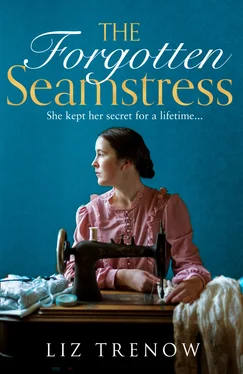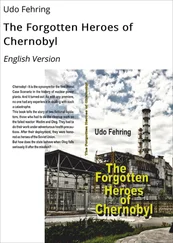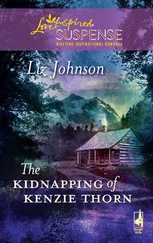As I went to put away the glasses, she called from the spare room: ‘I haven’t seen this quilt before. Is it yours?’
‘I’ve just brought it back from Mum’s; we found it in the loft at the cottage. It belonged to my granny. Look at this,’ I said, showing her the poem.
‘How bizarre. I’ve seen sampler verses incorporated into quilts, but never sewn into the lining like that. Do you know who made it?’
I shook my head. ‘Mum thinks it might have been made by a friend Granny met in hospital. It’s a bit of a mystery.’
‘Let me show you something else. See these?’ She pointed to the background behind the embroidery in the centre panel of the quilt. ‘And this one? Can you see the motifs, the sprays of flowers woven into the brocade?’
I peered more closely.
‘I’m not certain, but it reminds me of something I read recently, about the May Silks,’ she said, stroking the fabric with a reverent fingertip.
‘“May Silks”?’
‘They were designs created for the royal family around the turn of the twentieth century – George and Mary, that lot. Mary was particularly keen to support British designers and manufacturers and these designs were commissioned from a London studio run by a man called Arthur Silver. They were quite famous in their time.’
She handed me a tiny brass magnifying glass. ‘Take a look. You can see the rose, thistle and chain of shamrocks – symbols for the nations of the United Kingdom.’
‘What about the Welsh daffodils – or is it leeks?’
‘These flowers in the centre look a bit like daffodils, it’s hard to tell. But more important, can you see those silver threads? Isn’t it extraordinary?’
Looking closer, I could see what she was talking about. The pale cream silk seemed to have metal threads running through it, and woven into it were delicate designs of flowers and leaves, linked together as a garland.
‘Raise-a-fortune-at-Sotheby’s extraordinary?’
‘It won’t pay off your mortgage,’ she laughed. ‘But it would be really interesting from a historical perspective.’ She took back the magnifying glass and ranged over other parts of the quilt. ‘Quite apart from the interesting fabrics, the stitching is amazing. I expect you’ve noticed?’ She pointed to the maze design, a double row in the finest of chain stitches, perfectly even throughout its complex twisting pattern. ‘And the appliqué stitches are so tiny. I’ve never seen such neat needlework. Whoever made it was a brilliant seamstress,’ she said, straightening her back. ‘Was it your granny, you said?’
‘Granny did dressmaking but we never saw her doing embroidery. Mum thinks it might have been made by a friend of hers.’
‘Whoever it was, I’d love to know how they got hold of those fabrics. They were unique and very closely guarded because they were only to be used by the queen. Did she have anything to do with the royal family?’
I shook my head. Granny was always rather anti-establishment and certainly no royalist. She’d always been angry about the hardship my grandfather had endured, fighting in the First World War. ‘Lions led by donkeys’, I’d heard her say once and, when I asked what it meant, she explained that the generals leading the war were upper-class twits who had no idea what it was like for what she called the ‘cannon fodder’ in the trenches.
‘You mentioned a hospital?’
‘She was a patient at a mental hospital for a short time, probably just after the war. The only thing Mum can remember is that the quilt is somehow connected to the hospital, or perhaps someone she met there.’
‘I wonder whether the hospital had a royal connection, perhaps, or a link with the factory that wove the silk?’
‘Let’s have a look.’ I turned on my laptop and searched for ‘mental hospital, Eastchester’. Almost at once an archive site came up: A History of Helena Hall . ‘This must be it!’
Jo peered over my shoulder as we read:
This website is dedicated to the doctors, nurses, consultants and other staff who worked at Helena Hall Mental Hospital, as well as the many thousands of patients who were cared for there during its 84 years of serving the community.
The hospital, first named the Helena Hall Asylum, was opened to patients in 1913. At its peak it housed over 1800 patients, as well as medical and academic staff. The site demonstrates the changing approach of asylum layout through the early part of the 20th century, incorporating large ward-style buildings typical of the echelon style, yet having outlying villas typical of the colonial style.
The hospital began to release patients into the community in the 1970s and finally closed its doors in 1997. Since then the building has suffered from a number of arson attacks, especially on the main hall and the superintendent’s house. The site is to be regenerated, with the main administration building and wards being restored and converted to housing.
In the grainy black and white photographs, Helena Hall looked for all the world like a well-staffed stately home. Groups of pin-neat nurses posed proudly on the steps in front of a grand entrance with pillars on either side, and gardeners in three-piece tweed suits worked among meticulously-manicured lawns and precision-edged flower beds. But there was also a harsher reality: shots of long, empty wards furnished with plain white iron bedsteads ranged on either side in military rows, bewildered women patients in baggy dresses grinning toothlessly at the camera and men with ravaged faces and slumped shoulders blinking into the sunshine from a garden bench.
‘Jeez, look at this.’ Jo pointed to a photograph of nurses and doctors gathered by a bedside, with an alarming-looking machine sprouting wires towards an invisible patient.
‘Looks like ECT,’ I said, shivering at the thought that Granny might have endured such treatments.
A section on ‘Patient Life’ showed more recent, reassuring scenes: colour photographs of dances in the Great Hall, an arch-roofed affair decorated in blue and gold, hung with chandeliers with a large stage at one end bordered with ruby-red velvet curtains. Smiling people played cricket, badminton, tennis and bowls, and interior shots featured spacious rooms with gleaming parquet flooring, Persian rugs and comfortable three-piece suites. In one of the photos, entitled Ladies’ Needlework Room , women sat at tables in a sunny room working on embroidery and knitting.
‘Is it patchwork that lady’s sewing, do you think?’
I squinted closer at the screen. ‘Could be, it’s hard to tell. Can’t recognise anyone.’ The faces were largely concealed and certainly none looked anything like my grandmother.
It seemed that controversy over closure of the place had been raging for several decades, and future development plans were still keeping the local newspaper in front page headlines. The most contentious issue was the planned demolition of the Great Hall, which had been in use by local amateur dramatic groups and choral societies long after the hospital wards had closed. Many of the articles were by-lined: ‘Our chief reporter, Ben Sweetman.’
‘This guy seems to be a bit of an expert,’ Jo said. ‘He might be able to tell you whether the place had any royal links, or put you in touch with someone who might know, someone who used to work there, perhaps?’
‘You think it’s really that important to find out?’
‘A family heirloom with what looks like unique royal silk in it? It’s amazing. It’s up to you, of course but, whatever you decide, I’d really like to show it to my curator.’
‘The head of royal costumes? I thought you told me she was a dragon.’
‘She is, but I’ve warmed to her a bit since she renewed my contract.’ Jo checked her phone and yawned. ‘Ugh. It’s already past one and I’ve got to be at work early tomorrow.’
Читать дальше












